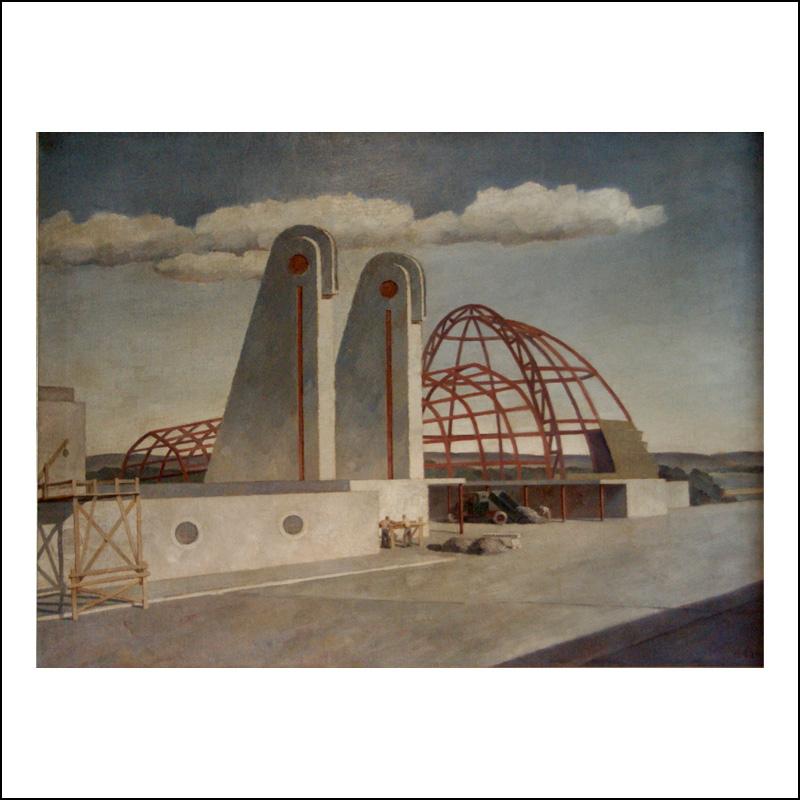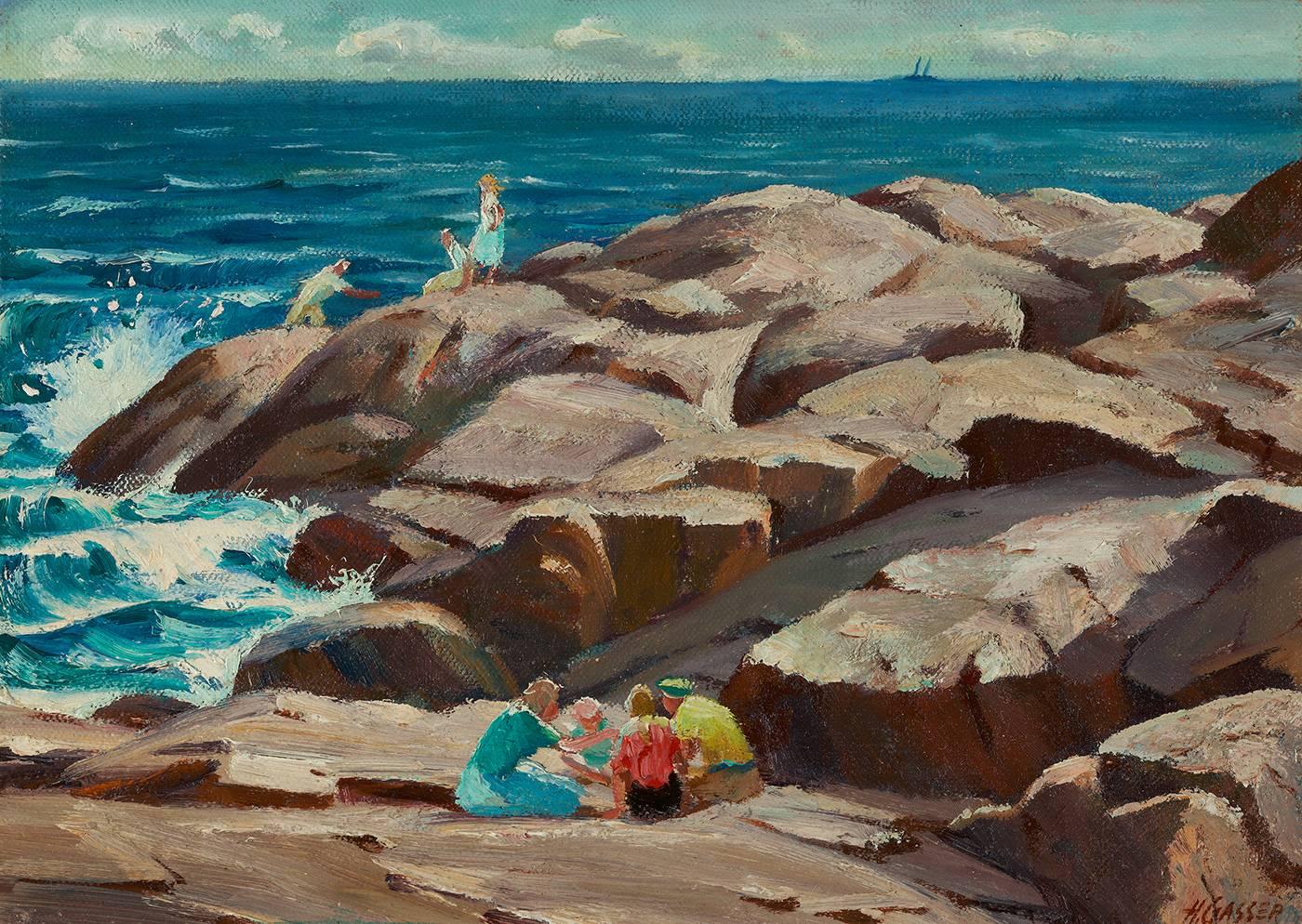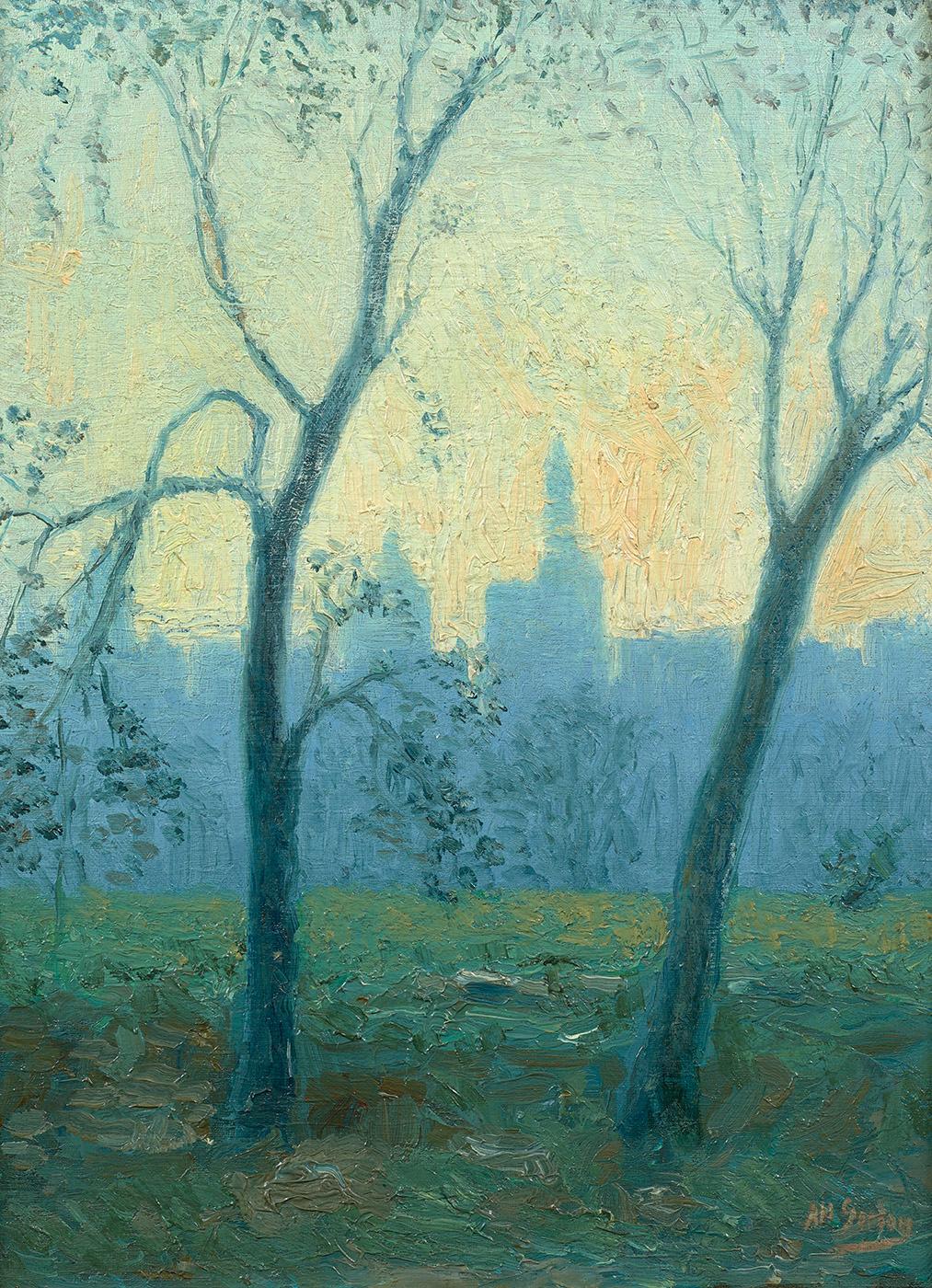Items Similar to "Mexican Mountains, " Hendrik Glintenkamp, Modernist Landscape
Want more images or videos?
Request additional images or videos from the seller
1 of 7
Hendrik Glintenkamp"Mexican Mountains, " Hendrik Glintenkamp, Modernist Landscape1940
1940
About the Item
Hendrik (Henry) J Glintenkamp (1887 - 1946)
Mexican Mountains, 1940
Oil on canvas
32 x 26 inches
Signed lower left; signed and dated on the reverse
The painter and illustrator Henry Glintenkamp (1887-1946) is known mainly for his anti-war illustrations that appeared in The Masses and other publications in the early twentieth century. As a painter, he was additionally successful, particularly in his landscape and urban scenes. Born in Augusta, New Jersey, the son of Hendrik and Sophie Dietz Glintenkamp, Henry received his elementary art training at the National Academy of Design (1903-06) before his study with Robert Henri the two years following.
Henri consequently attracted artists like Glintenkamp interested in returning to a sense of human qualities. Setting up his studio in the Lincoln Arcade Building with Stuart Davis and Glenn O. Coleman, Glintenkamp did work that reflects a preoccupation with urban scenes and landscapes.
In May of 1910 Glintenkamp exhibited his works as a student at the Henri School and at the Exhibition of Independent Artists of 1910. Two years later, he accepted the position of instructor at the Hoboken Arts Club in New Jersey and in 1913, he took up with others in the organization of The Masses, designed as a publication devoted to humanitarian causes. This publication stood in stark opposition to war, as its articles and cartoons reflected pacifism. At the Armory Show (1913), Glintenkamp exhibited The Village Cemetery. In 1917, Glintenkamp moved to Mexico to avoid the draft, and remained there until 1924, supporting "the socialist agenda of Mexico's new leadership."
The period following 1917 marks a new phase in the artist's development. Brighter in color and compositionally more involved, his later works are more discordant than the artist's earlier work. The artist sacrificed the atmospheric quality of the limited palette for the increased influence of modernist movements. After extensive travels in Europe, Glintenkamp returned to New York in 1934, and became a teacher at the New York School of Fine and Industrial Art and the John Reed Club School of Art. As chairman for the committee responsible for the organization of an Exhibition in Defense of World Democracy, in 1937, Glintenkamp continued his humanitarian purpose, though never really took up with the socialist rebels, many of whom followed similar groups and publications. Indeed, Glintenkamp was instrumental in founding the American Artists' Congress; he continued serving its needs as both the organization's president and secretary. A peripheral member of the impressionist-tonalist group in his early career, Glintenkamp had progressed through many American movements by the time of his death in 1946.
- Creator:Hendrik Glintenkamp (1887 - 1946, American)
- Creation Year:1940
- Dimensions:Height: 34 in (86.36 cm)Width: 28 in (71.12 cm)
- Medium:
- Movement & Style:
- Period:
- Condition:Excellent.
- Gallery Location:New York, NY
- Reference Number:1stDibs: LU184129905842
About the Seller
5.0
Platinum Seller
These expertly vetted sellers are 1stDibs' most experienced sellers and are rated highest by our customers.
Established in 2021
1stDibs seller since 2022
59 sales on 1stDibs
Typical response time: <1 hour
- ShippingRetrieving quote...Ships From: Larchmont, NY
- Return PolicyA return for this item may be initiated within 3 days of delivery.
More From This SellerView All
- "New York City Harbor, " Modernist View of Port and Boats on a Cloudy DayBy Bela de TirefortLocated in New York, NYBela De Tirefort (1894 - 1993) New York City Harbor, 1932 Oil on canvasboard 14 x 18 Signed and dated lower left: De Tirefort 32 Bela de Tirefort was born in Eastern Europe, painted...Category
1930s American Modern Landscape Paintings
MaterialsCanvas, Oil, Board
- "Buttermilk Bay, Cape Cod, " Georgina Klitgaard, Woodstock School Female WPABy Georgina KlitgaardLocated in New York, NYGeorgina Klitgaard (1893 - 1976) Buttermilk Bay, Cape Cod, Massachusetts, 1933 Oil on canvas 18 x 30 inches Signed lower right Provenance: Frank K. M. Rehn Galleries, New York Harold Ordway Rugg Private Collection, Western New York Georgina Berrian was born in Spuyten Duyvil, New York in 1893. She was educated at Barnard College...Category
1930s American Modern Landscape Paintings
MaterialsCanvas, Oil
- "Bucolic Landscape, " Sally Michel Avery, Female American Modernist Bright PastelBy Sally Michel-AveryLocated in New York, NYSally Michel Avery (1902 - 2003) Bucolic Landscape with Cows, 1963 Oil on canvasboard 9 x 12 inches Signed and dated lower left Provenance: The art...Category
1980s American Modern Landscape Paintings
MaterialsBoard, Canvas, Oil
- "Colorado Landscape, " Western Precisionist Regionalism American Scene PaintingBy William SandersonLocated in New York, NYReminiscent of an Edward Hopper or Andrew Wyeth scene, or even Charles Demuth with its cubist elements. William Sanderson (1905 - 1990) Colorado Landscape Oil on canvas 23 1/2 x 31 1/2 inches Signed lower right: Sanderson Born in Dubbeln, near Riga, Latvia in 1905, his personal journey from Czarist Russia, to New York City, and finally to Colorado, is one of remarkable courage and perseverance. Sanderson exhibited in numerous solo and group exhibitions throughout Colorado and the West between 1945 and 1985, and he was voted one of Colorado's influential artists of the 20th Century. Sanderson's paintings are represented in many museums and are sought after by collectors who appreciate his composition and precise use of color. The year 2005 marked the Centennial of Sanderson's birth, and he is now recognized as a major contributor to the development of modern art in Colorado. As a student at the National Academy of Design in 1927, Sanderson exemplifies an individual dedicated to creativity and the life-long passion for art. Known primarily as a Colorado artist, Sanderson first developed his skills as a graphic illustrator in New York City, and his work has appeared in numerous magazines, including New Yorker and New Masses. Notable book illustrations include The Jumping Off Place - 1929, by Marion Hurd McNeely, Jews Without Money - 1930, by Michael Gold...Category
Mid-20th Century American Modern Landscape Paintings
MaterialsCanvas, Oil
- "Tree, Trunk, and Roots, New York" Joseph Stella, American ModernismBy Joseph StellaLocated in New York, NYJoseph Stella (1877 - 1946) Tree, Trunk, and Roots, Bronx, New York, circa 1924 Oil on canvas 12 x 16 inches inscribed in another hand Joseph Stella/Estate and bears Joseph Stella Estate stamp (on the reverse) Provenance: The Estate of the Artist Rabin & Kreuger, New Jersey Parke Bernet Galleries, New York, March 14, 1968, Lot 147 ACA Galleries, New York Thence by descent Stella was born June 13, 1877 at Muro Lucano, Italy, a mountain village not far from Naples. He became painter laureate of Muro Lucano when he was in his teens with a representation of the local saint in the village church. Stella immigrated to America in 1896 and studied medicine and pharmacology, but upon the advice of artist friend Carlo de Fornaro, who recognized his undeveloped talent, he enrolled at the Art Students League in 1897. Stella objected to the rule forbidding the painting of flowers, an indication of his lifelong devotion to flower painting. He also studied under William Merritt Chase in the New York School of Art and at Shinnecock Hills, Long Island in 1901-1902, displaying the bravura brushwork and dark Impressionist influence of Chase. Stella liked to paint the raw street life of immigrant society, rendering this element more emotionally than the city realists, the Aschcan School headed by Robert Henri. Stella went through a progression of styles--from realism to abstraction--mixing media and painting simultaneously in different manners, reviving styles and subjects years later. The "Survey" sent Stella to illustrate the mining disaster of 1907 in Monongah, West Virginia, and in 1908 commissioned him to execute drawings of the Pittsburgh industrial scene. Steel and electricity became a major experience in shaping his responses to the modern world, and Stella succeeded in portraying the pathos of the steelworkers and the Pittsburgh landscape. Stella went abroad in 1909 at the age of thirty-two, lonely for his native land. He returned to Italy, traveling to Venice, Florence and Rome. He took up the glazing technique of the old Venetian masters to get warmth, transparency, and depth of color. One of Stella's paintings was shown in the International Exhibition in Rome in 1910 and was acquired by the city of Rome. The influence of the French Modernists awakened his dormant individuality. His friendship with Antonio Mancini, a Futurist, also played a role in his new style. At the urging of Walter Pach...Category
1920s American Modern Landscape Paintings
MaterialsCanvas, Oil
- "Manhattan Looking East, " Herman Rose, WPA New York City View from MidtownBy Herman RoseLocated in New York, NYHerman Rose (1909 - 2007) Manhattan Looking East (View from Midtown), 1952-54 Oil on canvas 26 x 28 inches Signed lower right Fairfield Porter wrote an essay in ArtNews on this exact painting in 1955. Please inquire for a copy of the article. Literature: Fairfield Porter, "Herman Rose Paints a Picture," ArtNews, April 1955 Volume 54, Number 2, illustrated. Herman Rose was best known for his depictions of cityscapes of New York City. Herman Rappaport was born in Brooklyn, New York. in 1909. Herman Rose was the professional pseudonym of Herman Rappaport. Originally trained as a draftsman and studied at the National Academy of Design from 1927 to 1929, he was later employed by the Works Progress Administration's Murals Division under Arshile Gorky from 1934 until 1939. In 1939, after experimenting with a variety of contemporary expressionistic styles, Rose decided to paint from life. Working mostly in East New York and East Canarsie in Brooklyn, and in Manhattan, Rose began to paint roof tops and street scenes. Rappaport began using the name Herman Rose when he held his first solo art exhibition in 1946 at the Charles Egan Gallery in New York City. Although he initially began as an Expressionistic painter, he became known for small, light-filled Impressionist paintings of still life, cityscapes and skies by the early 1950s. His paintings and images were often composed of very small dabs of paint and tiny, blurry "squares," which combined to create the image on canvas, his favorite medium. Often described as a "lyrical painter" Rose's work "interpreted traditional subjects: landscape, still life and the figure like the Post-Impressionists from whom he developed his own style, Rose built up forms from distinct touches of color that don't entirely blend in the viewer's eye. This gives his surfaces an active quality that flattens forms, one of the great lessons of modernism." Herman Rose's work received official recognition when Ms. Dorothy Miller of Museum of Modern Art (MoMA) included his work in an exhibition called, "15 Americans," alongside work by Clyfford Still, Mark Rothko and Jackson Pollock. New York Times art critic Hilton Kramer wrote of Rose's work in 1981, "{he} must surely be counted among the most beautiful works anyone has produced in this challenging medium for many years." The Art in America art critic Lawrence Campbell...Category
1950s American Modern Landscape Paintings
MaterialsCanvas, Oil
You May Also Like
- 1, 000 piece Museum Quality Collection of Art & Objects from NYC 1939 Worlds FairBy Harry LaneLocated in New York, NY1,000 piece Museum Quality Collection of Art & Objects from NYC 1939 Worlds Fair Harry Lane (1891-1973) "1939 World’s Fair Construction," 30 x 40 inches, Oil on canvas, signed lower...Category
1930s American Modern Landscape Paintings
MaterialsPlaster, Photographic Paper, Canvas, Oil
- "Garden Splendor"By Nicolai CikovskyLocated in Southampton, NYOil on canvas painting by the Russian/American artist, Nicolai Cikovsky. Signed lower left. In good unrestored condition. Housed in custom made wood and lemon gold gilt frame. Overal...Category
1940s American Modern Landscape Paintings
MaterialsCanvas, Oil
- On the SeashoreBy Henry Martin GasserLocated in New York, NYSigned lower right: H. GASSERCategory
20th Century American Modern Landscape Paintings
MaterialsCanvas, Oil
- "Twin Cities"By Nahum TschacbasovLocated in Southampton, NYThis rare and wonderful oil on canvas landscape by Nahum Tschacbasov was done circa 1947. A slightly smaller version of this painting by Tschacbasov called "Night and Day" is illust...Category
1940s American Modern Landscape Paintings
MaterialsOil, Canvas
- The Break of the HazeBy Aaron Henry GorsonLocated in New York, NYSigned lower right: AH GorsonCategory
1920s American Modern Landscape Paintings
MaterialsCanvas, Oil, Board
- Spring , Modernist Native American Ceremonial Scene and Cultural CommentaryLocated in Doylestown, PA"Spring" is a 25 x 30 inches, oil on canvas painting by American modernist and surrealist, female artist Peter Miller. The work is signed and titled on verso, and painted in a vibran...Category
1940s American Modern Landscape Paintings
MaterialsCanvas, Oil



